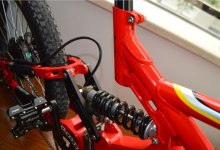duncmac
1 µW
Hello All
I've been reading through posts on here and in general having a browse around whats available for building up an ebike.
My motivation for getting into ebikes is looking to save a few quid and having some fun.
At the moment I motorbike into work each day, its a short commute 9ish miles each way, through a not unpleasant route into london from the southeast.
"9 miles you say? why dont you bike it in you lazy tart" well I am a bit lazy and theres a hill or two in the way.

So I'm looking to put together an ebike kit to put on an old steel frame marin moutain bike.
I'm mechanically minded but not yet got my head round the electricity side of things.
Question I have are, based upon my route and my need to be able to make the whole distance with minimal/no pedaling and the really steep hill at the start/end, speeds of not more than 30-35mph what kind of motor/battery am I looking at?
I'd rather spend on something thats a bit more over-engineered than I need and have it reliable/upgradable.
Is something like crystalites the crown and a ping 72v 15ah battery going over the top, what kind of controller would be needed?
I've been reading through posts on here and in general having a browse around whats available for building up an ebike.
My motivation for getting into ebikes is looking to save a few quid and having some fun.
At the moment I motorbike into work each day, its a short commute 9ish miles each way, through a not unpleasant route into london from the southeast.
"9 miles you say? why dont you bike it in you lazy tart" well I am a bit lazy and theres a hill or two in the way.

So I'm looking to put together an ebike kit to put on an old steel frame marin moutain bike.
I'm mechanically minded but not yet got my head round the electricity side of things.
Question I have are, based upon my route and my need to be able to make the whole distance with minimal/no pedaling and the really steep hill at the start/end, speeds of not more than 30-35mph what kind of motor/battery am I looking at?
I'd rather spend on something thats a bit more over-engineered than I need and have it reliable/upgradable.
Is something like crystalites the crown and a ping 72v 15ah battery going over the top, what kind of controller would be needed?





